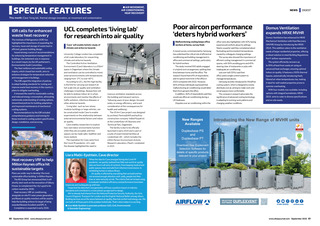




SPECIAL FEATURES AIR MOVEMENT, AIR CONDITIONING, HEAT RECOVERY This month: Cave living lab, thermal storage innovation, air movement and contamination IOR calls for enhanced waste heat recovery The Institute of Refrigeration (IOR) has highlighted the importance of expanding the recovery, reuse and storage of waste heat in efficient, greener building design. Issued among a series of recommendations for enhancing temperature management in buildings, the statement was in response to a recent inquiry by the UK parliament s Environmental Audit Committee. The Heat resilience and sustainable cooling inquiry, which closed last month, aims to enhance strategies for temperature reduction and management in buildings. The IOR urged the integration of policies to adapt building standards for cooling and improve waste heat recovery in the country s plans to mitigate overheating. It stressed the need for sustainable cooling and reduced energy consumption, advocating nationwide understanding of cooling options, streamlined policies for building adaptation, and improved maintenance of mechanical cooling systems. Recommendations by the IOR included comprehensive guidance and training for those involved in cooling system specification, design, installation, and servicing. UCL completes living lab for research into air quality Cave will enable holistic study of climate and airborne hazards University College London has completed a full-scale laboratory for researching climate and airborne hazards. The Controlled Active Ventilation Environment (Cave) laboratory is a 206m2 space in Dagenham where the climate and ventilation can be controlled to mimic external environments with temperatures ranging from -5C to over 40C. According to UCL, the 9m-high facility is the first for carrying out research at full-scale into air quality and ventilation challenges in buildings. Researchers will be able to analyse indoor air in urban environments and monitor the effects of traffic pollution, infectious diseases or other airborne hazards. Living labs, such as two-storey modular buildings or large vehicles, can be constructed inside Cave to enable experiments on the relationship between external environmental factors and indoor air quality. Cave enables researchers to explore how real indoor environments function when they are occupied, and how spaces can be made safer, healthier and more resilient. The inspiration for Cave came from the Covid-19 pandemic. UCL said the disease highlighted the need to Cave can accommodate two-storey building mock-ups improve ventilation standards across the building and transport sectors, following years of poor design, focused solely on energy efficiency, and scant consideration of the consequences for health and wellbeing . The 9.4m Cave project was designed by architect Perkins&Will and built by construction company VolkerFitzpatrick at the LondonEast-UK Business and Technical Park, Dagenham. The facility is due to be officially launched in early 2024 and is part of a suite of experimental facilities at LondonEast-UK which includes the 40m Person-Environment-Activity Research Laboratory (Pearl), completed in 2021. Liora Malki-Epshtein, Cave director Heat recovery VRF to help Milton Keynes office hit sustainable targets Plans are under way to develop the most sustainable office building in Milton Keynes. The RO Group has announced that it will shortly start work on the renovation of Silbury House, to complement the city s goal to be carbon-neutral by 2030. Heat recovery VRF air conditioning, alongside on-site PV solar power generation and Reset air quality monitors will be used to help the building achieve its target of being awarded Breeam Excellent and EPC A. Completion is expected in early 2024. 60 September 2023 www.cibsejournal.com When the idea for Cave emerged during the Covid-19 pandemic, we quickly realised how little real-world air quality data we have in all sorts of contexts, from keeping medical and public spaces clean and safe from infection transmission, to ventilating homes to reduce illness. Air quality is affected by everything that we build and has not received enough attention until, sadly, people lost their lives or were seriously at risk. The criteria that weve been using to evaluate ventilation efficiency and performance have been imprecise and inadequate up until now. I hope that the data that Cave generates will have a positive impact on industry standards and contribute to a more joined-up approach to design. Weve already had interest from the National Protective Security Authority, the Arts Council England, Transport for London and the English National Ballet among others. Building services are at the nexus between air quality, thermal comfort and energy use. We can look at all those parts of the problem holistically. Thats what makes it so exciting. Liora Malki-Epshtein is associate professor (UCL Civil, Environmental & Geomatic Engineering)